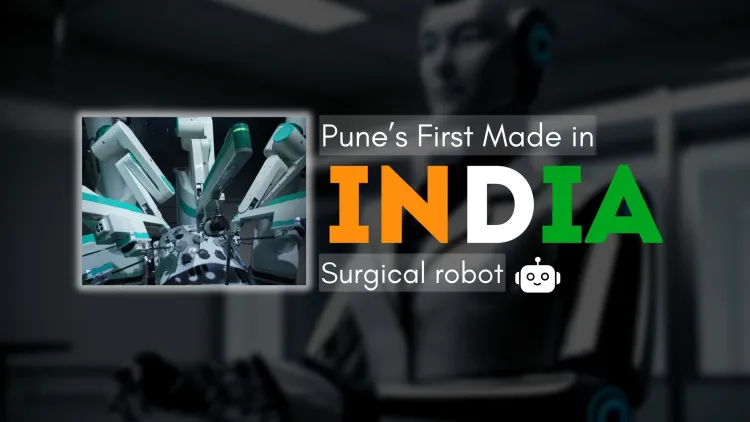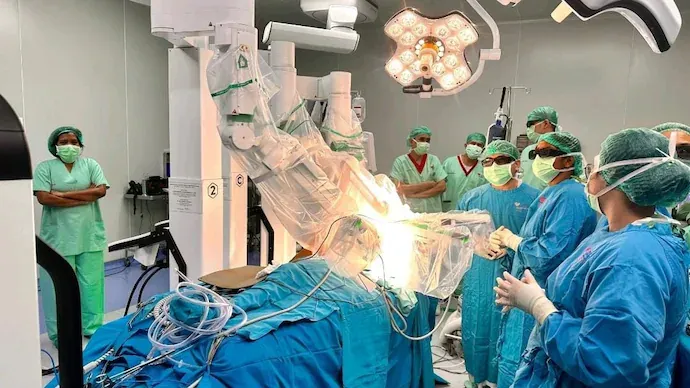Pune's First Made-in-India Surgical Robot | Revolutionizing Healthcare with AI and Cybersecurity
Pune's Noble Hospitals has introduced India's first Made-in-India surgical robot, the SSI Mantra, developed by SS Innovations. This advanced system, approved by the Central Drugs Standard Control Organisation (CDSCO), is designed to perform complex surgeries with greater precision using five robotic arms, a 3D HD headset, and 3D 4K imaging. The robot is particularly useful for general surgeries, cardio-thoracic surgery, urology, and gynaecology, offering minimally invasive procedures that reduce recovery time and improve patient outcomes. The integration of AI in robotic surgery enhances precision, enables real-time data analysis, and provides predictive analytics for better surgical outcomes. However, AI in surgery also brings challenges, such as high costs and dependence on technology. Additionally, cybersecurity is critical in ensuring the safety of these robotic systems from cyber threats like data breaches and hacking. As robotic surgery continues to evolve, its impact on heal

In a groundbreaking move for India's healthcare sector, Pune's Noble Hospitals and Research Centre has become home to the country’s first Made-in-India surgical robot. The SSI Mantra surgical robot, which recently received approval from CDSCO (Central Drugs Standard Control Organisation), signifies a major leap in medical technology. This robotic surgery system promises to enhance surgical precision, reduce recovery time, and transform patient care. In this blog, we’ll explore the SSI Mantra robot, its cutting-edge features, and the role of AI and cybersecurity in ensuring its success.

What is the SSI Mantra Surgical Robot?
The SSI Mantra surgical robot is a state-of-the-art robotic surgery system developed by SS Innovations, founded by Dr. Sudhir Srivastava. This Made-in-India surgical robot recently received the much-awaited approval from India’s regulatory body, CDSCO, which oversees the safety and effectiveness of medical devices.
Key Features of the SSI Mantra Surgical Robot:
- Five Robotic Arms: The system boasts five lean robotic arms that provide the surgeon with enhanced precision and flexibility during surgery.
- Immersive 3D HD Headset: Surgeons use a 3D HD headset for a detailed, magnified view of the surgical site, ensuring superior control and visualization.
- 3D 4K Imaging: The vision cart offers 3D 4K imaging, providing an incredibly detailed view for the entire surgical team, further improving surgical outcomes.
- Minimally Invasive Approach: By using tiny, fingertip-sized incisions, the system minimizes patient trauma, reduces recovery time, and accelerates healing.
How Does Robotic Surgery Work?
Robotic surgery involves a surgeon controlling robotic arms through a console while viewing the surgical site in 3D on a high-definition monitor. The console allows for precise control over the instruments, while the system’s advanced features ensure safety and accuracy.
With the SSI Mantra robot, surgeons can perform a range of surgeries with greater precision than traditional methods. This includes complex procedures like general surgeries, cardio-thoracic surgery, urology, and gynaecology, all with enhanced control and minimal patient discomfort.
The Role of AI in Surgical Robotics
Artificial Intelligence (AI) plays a significant role in advancing robotic surgery, as it enhances the robot’s ability to perform delicate operations with greater accuracy. AI-powered systems can also analyze real-time data, assist in decision-making, and even predict complications during surgery.
How AI Enhances Surgical Precision:
- Real-Time Data Analysis: AI algorithms process patient data, such as medical imaging and vital signs, to assist surgeons in making more informed decisions.
- Learning and Adaptation: AI systems can learn from past surgeries, improving their precision and adjusting in real time during a procedure.
- Predictive Analytics: AI can predict complications and alert the surgical team to potential risks, helping to mitigate issues before they arise.
- Enhanced Control: The AI-powered robot offers real-time feedback, ensuring that the surgeon has all the necessary information for precise movements.
The Pros of AI in Robotic Surgery:
- Increased Precision: AI-driven systems allow for tiny adjustments that humans cannot achieve, improving surgical outcomes.
- Faster Recovery: By using minimally invasive techniques, AI enhances the recovery process, reducing the time needed for patients to return to their normal routine.
- Remote Access to Expertise: AI facilitates telesurgery, where surgeons can perform surgeries remotely, providing access to expertise even in the most remote areas.
The Cons of AI in Robotic Surgery:
- High Cost: AI and robotic surgery systems are expensive, limiting their availability, especially in underserved regions.
- Dependence on Technology: Surgeons may become overly reliant on AI, reducing their proficiency in traditional surgery techniques.
- Cybersecurity Risks: The reliance on interconnected systems exposes the technology to the threat of cyberattacks.
Cybersecurity and the Role it Plays in Robotic Surgery
With the integration of AI and robotic systems in surgery, cybersecurity becomes an essential component to ensure patient safety and data protection. As these systems depend on data exchange, network connectivity, and AI algorithms, they are vulnerable to various cyber threats.
Cybersecurity Risks in Robotic Surgery:
- Data Breaches: Patient data, including sensitive health information, could be exposed if the system is hacked or improperly secured.
- Hacking of Robotic Systems: Hackers could potentially take control of robotic systems, causing them to malfunction and endangering patients' lives.
- Ransomware Attacks: Cybercriminals could lock hospital systems, including robotic surgery systems, demanding a ransom for their release.
Ensuring Cybersecurity in Robotic Surgery:
- Data Encryption: Data transmitted between the robotic system and hospital servers should be encrypted to prevent unauthorized access.
- Multi-Factor Authentication: Surgeons and medical staff should use multi-factor authentication to prevent unauthorized control of robotic systems.
- Regular Updates and Patches: Robotic systems must be updated regularly to ensure vulnerabilities are addressed and security is maintained.
- Intrusion Detection Systems: Hospitals should implement firewalls and intrusion detection systems to detect and prevent cyberattacks.
The Pros of Cybersecurity in Robotic Surgery:
- Protects Patient Data: Strong cybersecurity measures help prevent unauthorized access to patient information, ensuring privacy and compliance with data protection laws.
- Ensures Safety: Robust cybersecurity protocols safeguard against system malfunctions caused by cyberattacks, ensuring safer surgeries.
- Prevents Downtime: Security measures reduce the risk of ransomware attacks, ensuring that critical medical systems are always operational.
The Cons of Cybersecurity Challenges:
- Complexity: Securing robotic systems involves constant monitoring and updates, making it a complex and resource-intensive task.
- High Costs: Implementing advanced cybersecurity solutions can be costly, especially for smaller healthcare facilities.
- Human Error: Even with the best systems in place, human error remains a risk, particularly in configuring or managing cybersecurity settings.
Conclusion
The installation of the SSI Mantra surgical robot at Noble Hospitals in Pune is a milestone for India’s healthcare industry. By leveraging AI and robotic surgery, the country is now at the forefront of medical technology, offering improved precision, faster recovery, and enhanced patient outcomes. However, as we adopt this revolutionary technology, addressing cybersecurity risks is essential to ensure its safety and effectiveness.
As AI and robotic surgery continue to advance, India is poised to revolutionize the way surgeries are performed, making them more accessible, precise, and minimally invasive. With continued focus on cybersecurity and patient safety, these technologies have the potential to transform global healthcare and significantly improve patient care.











![Top 10 Ethical Hackers in the World [2025]](https://www.webasha.com/blog/uploads/images/202408/image_100x75_66c2f983c207b.webp)



![[2025] Top 100+ VAPT Interview Questions and Answers](https://www.webasha.com/blog/uploads/images/image_100x75_6512b1e4b64f7.jpg)







